SmartMotion e20 Folding Electric Bike
Updated 22 November 2023
Updates: 11000 km - Cameras - Hinge Clamp Adjustment - Brake cut-outs - LCD display error at 6553.9 km - Mirrors - Saddle Adjustment - Charging - First Puncture

Désirée - electric bike distance =12425 km. Total all bikes = 15468 km since mid March 2013
John - electric bike distance = 11814 km. Total all bikes = 21832 km since early January 2013
Contents
Use the browser "back control" to return here.
- Introduction
- Design,
Bike Specification,
Geometry,
Weight Distribution,
Electrical Specification
- Motor Details,
Electric Motor Properties,
Power requirements for cycling
- Battery Details,
Battery Capacity,
Range,
Charging,
Local riding
- Control,
Pedelec Controller,
10 Magnet Pedelec Disk Upgrade,
LCD Display
- Components,
Saddle,
Lock,
Folding Clamps,
Chain Guard,
Cassette,
Wheels,
Tyres,
Tyre Pressures,
Potholes and Wheel Size,
Brakes
- Additions,
Mirrors,
Bags,
Cameras
- Adjustments, Saddle Adjustment, Kick Stand, Mud Guard, Throttle Control, Walking assist, Wear, Chain Lubrication, Spoke Tension
- Specific Folding Bike Adjustments,
Hinge Clamp Adjustment,
Set Screws
- 1000 km, To Kaiteriteri 11 - 18 March 2015, Return Trip, Maintenance
- 2000 km
- 3000 km
- 4000 km
- 5000 km
- 6000 km, LCD display error at 6553.9 km, First Puncture
- 7000 km
- 8000 km
- 9000 km
- 10000 km
- 11000 km
- 12000 km
- Conclusion
Introduction
We purchased two SmartMotion e20 electric folding bikes from Wellington Electric Bikes on the 14th of November 2014. This was the result of a long period of research using some of the links at right. The intention was to match our abilities on hills so we could do some more challenging rides together. These rides will be described in Dizzy's folding bike blog.
I first considered a conversion of our Giant Expressway 2 bikes but the cost was not too far away from that of new bikes. The sale of our old bikes would make up even more of the difference. I may return to a mid-drive conversion of my old Tarini Mountain bike in the near future. In the meantime I have completed several local routes which I previously found to be hard solo rides. Now we can do them together while still putting in a fair effort.
The personal fitness gained may allow a non-electric bike to be ridden in areas that were initially a challenge, even for an electric bike. In my case I ride my old Tarini mountain bike, now fitted with Maxxis Cross Country DTH 26 inch BMX style tyres. In the front the tyre is 2.3 inches or 58.4 mm wide and in the rear the tyre is 2.15 inches or 54.6 mm wide. I have also updated my Jamis Allegro Sport hybrid bike with Vittoria Randonneur Tech 42 mm wide tyres. In both cases the the ride quality is greatly improved and I can ride up most hills and on a variety of surfaces.
Enlarge the photos by clicking on them. Use the web page back control < to return to the web page.
Design
The bikes are similar to designs from Dahon or Tern except the wheel base has been lengthened. A detailed description can be found on the SmartMotion website. I weighed the bike at 24.5 kg which is similar to the weight of an average 7 to 8 year old child. Removing the 4.02 kg battery reduces the weight to that of a 6 year old child.
Many electric bikes are much the same weight, about 25 kg. If you find a lighter design this is because the battery capacity is less, the motor is low powered, the range is poor, the frame has an exotic design or materials, the tyres and wheels are lightweight or there are few added refinements such as mudguards, a carrier, a built-in lock, and lighting. Electric bikes need to be strong, which can also make them heavier. The forces on the frame and wheels are greater than normal. The extra weight on the rear wheel - battery, carrier and motor - is about 8 kg. This is less than the weight variation among a range of people, so there is not much to worry about.
A non electric Dutch style bike with a similar standard of equipment and accessories might weigh around 20 kg. For example the Gazelle Tour Populair weighs 22.6 kg.
Bike Specification
- Model: SmartMotion e20 Folding Electric Bike
- Price: $2399
- Warranty: 2 years battery, 6 years frame, 1 year other items
- Frame: 6061 T4 T6 aluminium alloy
- Fork: 6061 aluminium alloy
- Handlebar and grips: Folding contoured flat bar style with adjustable rotation, upright riding position
- Stem: Black alloy, adjustable height
- Brakes front: Tektro V brake
- Brakes rear: Tektro V brake
- Wheels: 36 spokes, 2.25 mm diameter, 13 gauge
- Rims: Alex DM24 aluminium alloy double wall 20 inch
- Tyres: Kenda K1088 20 X 1.95 inch tires, Kevlar guard puncture protection, reflective sidewalls
- Tubes: Valve - Schrader type
- Front Hub: JoyTech alloy adjustable
- Rear Hub: Shimano 8 speed 11-34 teeth cassette
- Chain Ring: 52 teeth, 170 mm crank arms, Dual chain guards, CNC black
- Chain KMC Z51RB rust resistant
- Derailleur: Shimano Altus 8 speed
- Shifter: 8 speed Shimano Rapid-fire Plus shifter
- Mudguards: Polypropylene with stainless steel stays
- Saddle: Velo Plush Comfort
- Seat-post: 400mm long 30.4mm diameter suspension seat post
- Bottom Bracket: Sealed bearing cassette
- Pedals: Wellgo aluminium platform, foldable with reflectors
- Attachment points: Water bottle, carrier, brakes, reflectors, mudguards, lock
- Lock: Built-in C type, different key from battery
- Carrier: Spring top, elastic hold-down, pannier rails and battery support
- Lighting: LED front and rear Spanninga lights powered from main battery
- Cables: External routing
- Kickstand: Centre mounted adjustable kickstand
- Certification: Bike EN15194 & AS:NZ1998, Battery UN38.3
Geometry
- Bottom bracket height: 295 mm
- Chain-stay length: 455 mm
- Wheelbase: 1065 mm
- Equivalent horizontal top tube length: 567 mm
- Seat-tube angle: 77 degrees
- Head-tube angle: 72 degrees
- Saddle height minimum: 830 mm,
- Saddle height maximum: 1030 mm
- Wheel circumference: 1580 mm
- Pedal crank length 170 mm
- Overall length: 1618 mm
- The folded bike can fit in a box 900L x 710H x 550W (mm) with the Pedals unfolded.
The extended wheelbase means I can use my old pannier bags without any heel contacts when pedalling.
Weight Distribution
- Bicycle weight: 24.3 kg
- Basic bike without Saddle 14 kg
- Motor 3 kg
- Carrier 1 kg
- Battery 4 kg
- Lock 0.4 kg
- Saddle 0.6 kg
- Suspension seat post 0.6 kg
- Kickstand 0.3 kg
- Controls, sensors, lights, display and wiring 0.6 kg
Some weights are estimates.
Electrical Specification
- Motor: SmartMotion 36 volt, 300 watt, 380 rpm planetary geared motor for a 20 inch wheel
- Battery: Smartmotion International Ltd, lithium-polymer weatherproof, 36 volt, 15.6 amp hour, 560 watt hours
- Range: Nominal range at 10 watt hours per km is 56 km
- Battery ports: 42 volt DC into charging port, 5 volt DC out of USB device charging port
- Battery lock: Unlock to remove battery for charging inside, if cold
- Controller: Behind battery on carrier
- Throttle: Grip control left hand
- Cutouts: Brake lever motor cutouts
- Electrical cables: External routing
- Electrical connections: Marine grade weatherproof
- Display: Bigstone BST-C30036 LCD type, 5 pedal assist levels, motor current, battery state, 6km/h walking assist, speed and odometer readings
- Lights: LED Front and rear powered from main battery
- Charger: Modairy, 42 volt, 2 amp
Motor Details
The motor is a Japanese designed Dapu 36 volt, 300 watt unit. It weighs about 3 kg. The motor has the following codes placed in a hard to read location behind the cassette: Rated Voltage 36V Rated Power 300W 20 inch M155 CD3610 1LA 1312 A379. The motor is probably an OEM version of the Japanese designed Dapu M155 motor.
The maximum motor speed default setting is 30 km/h. Testing the bike on a nearly flat road, with a light following wind, achieved a maximum bike speed of about 28km/h. The controller keeps the maximum speed constant over a range of battery voltages. Hills, wind and weight also affect the maximum speed. So far on all my hill rides I have not detected any significant heating of the motor, so it must be reasonably efficient.
Electric Motor Properties
An electric motor can act as a generator. For a given voltage the motor will have a maximum speed where the generated voltage is nearly equal to the applied voltage. In this state little current is drawn and little power is available from the motor. The SmartMotion E20 has a maximum speed of about 35 km/h. The controller set maximum speed is 30 km/h. By loading the motor down to about 66% of the set maximum speed the power output is at a maximum. This is about 20 km/h in level 5.

By reducing the load so the motor runs at 75% of the set maximum speed the efficiency is maximised. This is about 23 km/h in level 5. At this speed most of the energy in the battery contributes to forward motion of the bike rather than heat. These speeds reduce in proportion at lower assist levels so at level 3 a speed of 15 km/h is economical. With a tail wind on the flat you may well go faster but the motor won't be helping much.
The table below is a rough guide to help with choosing assist levels for best performance. The numbers are at the lower end of a small range of suitable values. There is a power use bar on the top left of the display. It gets longer when the motor current increases. Keeping the length of this bar minimised will increase the range of the bike.

Power requirements for cycling
Cycling at 30 km/h, on the flat, under calm conditions on a normal upright bike, requires about 205 watts. A fit rider can supply this power, at least for a while.
If there is a 20 km/h headwind, the power required increases to about 480 watts. A normal cyclist will slow down under these conditions. The cyclist will need to provide an input power of 218 watts to maintain a speed of 20 km/h into a 20 km/h headwind.
If the slope increases to 5%, that is, a rise of 5 metres for every 100 metres of horizontal motion, the power requirement, at a speed of 20 km/h into a 20 km/h headwind, increases to 540 watts. The normal cyclist will slow down further, as this power cannot be provided.
At 10 km/h, on a 5% slope into a 20 km/h head wind, the cyclist will need to provide 230 watts of input to maintain that speed.
Under each scenario the cyclist will be fairly hot and sweaty at the destination. An electric bike can make these riding conditions much more enjoyable. A legal motor can provide up to 300 watts of assistance, which can make a long trip a pleasant experience for a less able rider. For physical fitness, the motor input can be dialled down so that it is only assisting on the more difficult riding sections. In this case the range will be greatly increased.
A cyclist climbing a hill, with a 12% slope, needs 240 watts of power input to go up it at just 6 km/h. With the aid of a 300 watt electric motor, and 100 watts of input from the cyclist, the speed up the same 12% hill would now be in excess of 10 km/h. At the destination the cyclist would be in a much better condition to socialise and to enjoy the view. Recently we joined two group rides, which included some steep Wellington hills. The electric cyclists on the trip each took almost the same time to climb the hills.
Battery Details
The bike has a 36 volt 15.6 amp hour lithium polymer battery. The battery can be removed from the carrier with a key. There is no start key, only a button on the back of the battery pack. Power is turned on in two steps: pressing the button at the back of the battery, and then turning the controller LCD display on. The LED bike lights run directly off the battery. There is also an included USB phone charging port.
Battery Capacity
It is possible to estimate the remaining battery capacity from the unloaded battery voltage.
The received engineering wisdom is that it is meaningless to measure the unloaded voltage to determine the remaining battery capacity. Most discharge-graphs in battery specification sheets relate to batteries under load. In this case the load is highly variable making a measurement of capacity, under the applied loads, meaningless. There is a reasonable and convenient relationship between unloaded voltage and capacity for lithium batteries.
A Lithium polymer battery with 100% remaining capacity reads about 41.7 volts unloaded. At 0% remaining capacity the unloaded reading is about 36 volts. A plot of unloaded voltage vs remaining capacity is linear up to about 40.5 volts or 85% remaining capacity. There is little added capacity from 41 volts to 41.7 volts.
When the motor load is applied to the battery at 36 volts the voltage may drop to around 31 volts. This should cause the controller to disconnect the battery to protect it from damage.
The graph below was derived from user experiences with lithium-polymer batteries in radio controlled aircraft, where unloaded measurements were made after the flight. The curve becomes seriously non-linear above 41 volts which indicates that, in addition to simple charging, other electrode reactions are occurring. There is a chemical reaction of the negative electrode with the electrolyte. Insulating reaction products are slowly deposited on the negative electrode surface, which reduces the available current and shortens the battery life. Electrolyte additives are used to limit this process. How to Make a Lithium Battery Last is a good scientific article and video on these processes.

The battery chargers get warm in use, so I place them on an aluminium plate to help dissipate heat. The lifetime of electronics is usually shortened at higher temperatures. On carpet, I would suggest supporting the charger on two pens to provide some air circulation underneath.
Range
The stored energy in the battery, in watt hours, is a most important specification as it determines, potentially, how far the bike can go. A way to compare bike ranges is to calculate the battery voltage times the battery amp hour capacity and divide the result by 10 watt hours per km. The result is a nominal range in kilometres.
For my bike the battery energy content is 36 volts x 15.6 amp hours = 562 watt hours. Dividing 562 watt hours by 10 watt hours per km = 56 km which is the range for an energy use of 10 watt hours per km. A 12 amp hour battery therefore has a range of 43 km. For our riding style, these distances are an underestimation.
We get a very long range at our riding speeds. One long ride, in Hawke's Bay, was 62 kilometres which still left us with a lot of battery capacity remaining. Some hill rides in the Picton and Nelson areas were a little longer.
I have no idea of the full range of these bikes. This depends on the individual riding styles, speed, terrain and wind velocity.
An interesting web based calculator estimates the power required to produce a given bike speed.
Charging
2 amp chargers are provided which, under normal use, can charge the battery to 41.7 volts. In my case I have designed a diode splitter cable which allows the two batteries to be charged to about 40.7 volts at a 1 amp rate. I can choose voltage drops from 0.39 to 1.2 volts depending on the splitter I use. This lower voltage reduces the range slightly but can greatly improve the battery lifetime. One charger can top up two batteries overnight. The lower 1 amp charging rate is also beneficial. Occasionally the splitter is removed from the battery charging input to ensure the battery balancing circuits are properly activated. As long as the batteries are not fully discharged all cells should reach the same voltage. Detrimental chemistry occurs at low and high battery voltages. In the middle range of voltages the battery lifetime is very long. This is how satellites use and charge lithium batteries for a very long operational life.
A good way to help preserve battery life is to only charge the battery as part of the preparation for the next ride. Currently our batteries are 9 vears old, with little change in performance. Range and power levels are still good.
Some notes on battery problems are on my SmartMotion Vista page and battery management systems are well covered in this Battery Management System Tutorial.
Grin Technologies has a lot of useful information about motors, batteries, chargers and the Cycle Analyst.
Local riding
Wellington is known for its steep hills and strong winds. Typically, we ride around Wellington at 15 to 25 km/h on level 2 or 3 assist. Above 20 km/h no power is taken from the battery on level 3 assist. This extends the range.
On gentler hills, and into moderate head winds, 17 km/h is a common speed. On steep hills our speed may reduce to 10 km/h which is still reasonably efficient at these assist levels. I use the throttle occasionally to help at intersections and to start on hills.
Note that here I express the steepness or grade of a hill as a percentage defined as 100 times the tangent of the slope measured in degrees. The tangent is the vertical rise divided by the horizontal distance. An 8 degree slope is a 14% grade with a tangent of 0.14. A 7 degree slope is a 12% grade with a tangent of 0.12.
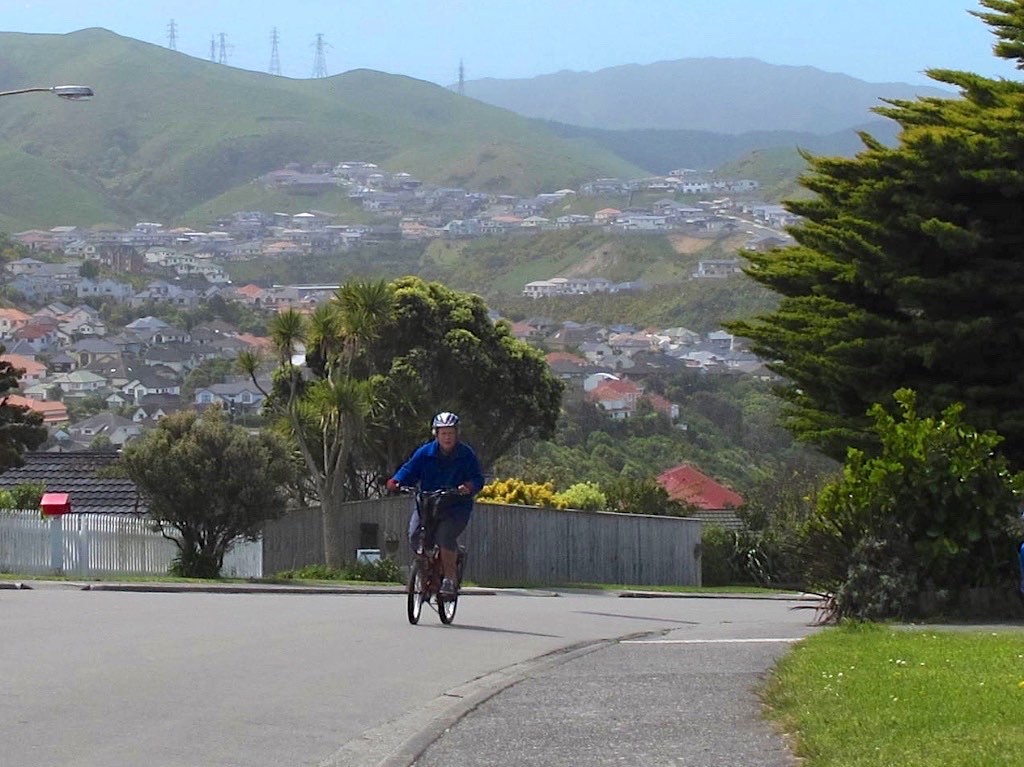
For serious hill climbing, it is better to reduce the assist setting to 2 or 3, change down the bike gearing and to go uphill more slowly. This is counter-intuitive, but it is more efficient, producing much less wasted heat in the motor, controller and battery. Pedalling in a suitable low gear will help to maintain the optimum speed. Going too fast or too slow uphill is inefficient.
Using lower assist settings on hills shifts the motor's maximum-efficiency speed downwards. This means that the motor and controller won't overheat when under load. The tradeoff is that less power is available, so some extra pedalling effort is needed.
You can roughly calculate that the optimum speed on hills at level 3 should be 0.75 x 20 = 15 km/h for efficiency and 0.66 x 20 = 13 km/h for maximum power. There is a wide tolerance on these figures so a speed several km/h slower is still efficient.
The battery current is displayed at the top left of the display as a series of bars. Keeping the displayed bar length short greatly improves the range.
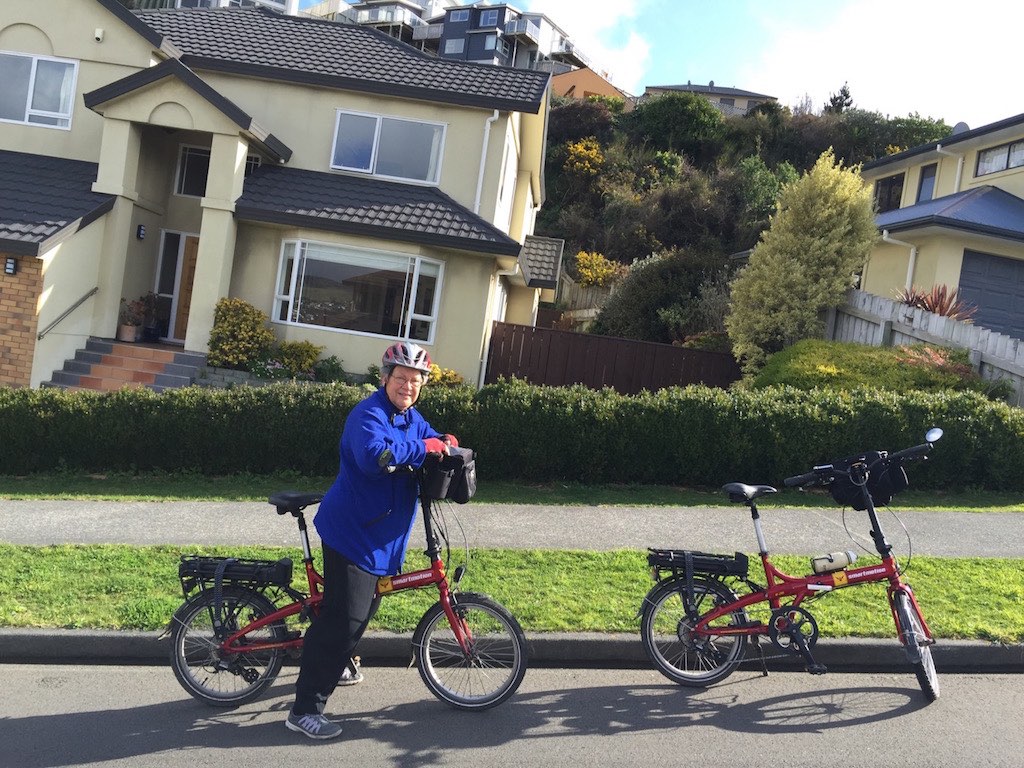
In Wellington I have ridden the Johnsonville - Makara Village - Karori - Johnsonville loop several times without any problems. I also rode this loop on my unpowered Jamis Allegro bike, with a bit more effort.
Another good ride was from home, in Churton Park, to Wadestown. I walked the bike up the extremely steep Weld Street, using the 6 km/h walking-assist function. This was followed by an easier ride over the top of Tinakori Hill to Northland.
I turned down the narrow Orangi Kaupapa Road to Garden Road, Glenmore Street, Tinakori Road, Hutt Road and finally up the Ngauranga Gorge back home. This was a pleasant ride with some work required on the steeper bits.
Although I could probably ride up the 18% grade of Weld street I felt it would stress the bike, and me.

Listening to the motor helps to run the bike more efficiently. The motor makes more noise when it is running slow, under load. In this state the motor is wasting a lot of battery power as heat and the motor wear rate will be much greater.
Control
Pedelec Controller
Controller design and programming helps to get the best performance out of the motor. The controller pulses the motor on and off at a high frequency to enable the motor to run slower at 36 volts. Depending on the duty cycle of the pulses this is an efficient way to reduce the net voltage and speed. The reduced speeds are achieved with little wasted heat in the controller or the motor. In addition a programmed initial acceleration increases the motor efficiency during start up.
A disk, located behind the chainwheel, contains 5 cubic pedelec magnets. It rotates with the chainwheel. The magnets pass a single Hall sensor which sends a signal to the controller to start the motor. The magnets are orientated sideways which means that the motor will not start when back-pedalling.
When pedalling forwards the magnetic poles, N = North, S = South, pass the sensor as NS......NS......NS......NS......NS. Pedalling backwards produces SN......SN......SN......SN.......SN. The controller is programmed to tell the difference so the motor assist is only produced if the pedalling direction is forward. The magnet polarities can be measured with a small compass.
The blunt south end of a simple compass needle points to the south magnetic pole of the earth. The Earth's south magnetic pole is actually the north pole of the Earth's natural magnetic field.
The sharp north pole of the compass needle points to the Earth's north magnetic pole. The Earth's north magnetic pole is the south pole of the Earth's natural magnetic field.
The north pole of a magnet is the one which tends to point north. This can be somewhat confusing. If a compass encounters the north pole of a magnet the south pole of the compass needle will point towards it.

There are other pedelec systems with two hall sensors. In this case the magnets have their poles facing outwards. The magnetic disks from one system will not run on the other.
There are 10 holes in the SmartMotion Pedelec disk and only 5 are filled with a magnet. At present it takes 3/4 of a crank revolution before the motor starts. With 10 magnets it will take only 3/8 of a crank revolution before the motor starts.
Reducing the motor start-up delay should make the bike more natural and responsive to ride. The motor and controller is capable of an instant start using the throttle, so a delayed start of 3/8 of a crank revolution should do no harm.
The magnets play no role in measuring the bike speed so the display contents should be the same as before. The speed of the bike should also be the same. There may be some additional control issues when stationary but the brake cutout switches should manage that.
10 Magnet Pedelec Disk Upgrade
I was kindly given a spare pedelec disk by Cliff Randall at Wellington Electric Bikes. I was able to press the magnets out of this disk using a wooden chopstick. I pressed the 5 magnets into the disk from my bike, after using a compass to test the correct orientation of the magnets. The poles lie sideways with the north pole arriving at the sensor first. The north pole of a magnet attracts the south pole of a compass needle. A small screwdriver can be used to test that the magnets are indeed lying sideways. It will only be attracted to the leading and trailing edges of the magnet and not the middle,
First, I had to remove the disk from my bike by removing the chain-wheel. I used some BluTac to immobilise a single magnet on a desktop in the correct orientation. I then pressed the disk over the immobilised magnet. I used a soft-faced instrument vice to complete the pressing operation. The magnets are brittle so the pressure should be even.
Some plastic may be expelled from the hole during the pressing operation. Remove this with a knife and repeat the pressing operation. If the magnets are loose in the holes, use some superglue to secure them. Wipe off the excess glue immediately using a cloth dampened with methylated spirits.
The magnets are attracted to nearby steel items and to the other magnets, which can be a little frustrating. A simpler method might be to place one disk over the other and then to press or tap the magnets through from one disk to the other.
The magnets facing the sensor should be flush with the disc otherwise they may catch on the sensor. If teeth are missing from the middle of the disk the likely cause is projecting magnets. The disk can be set in place on the bottom hub shaft by using a temporary paper or thin plastic shim to ensure the disk does not touch the sensor or wobble. Nail polish can be used to set the disk in place on the shaft.
4 mm cubic N35 magnets are available on Ebay.
After about 1000 km of testing, the new Pedelec disk performs exactly as expected. The bike is now much more responsive. The motor now starts helping after the cranks have rotated just 3/8 of a turn. The bike feels safer when getting underway at intersections. This is probably easier on the motor and controller than relying on the throttle for that purpose.
The motor start-up acceleration rate depends on the speed at which pedelec magnets pass the sensor. This means that pedalling fast in a low gear will produce an increased motor acceleration rate. The new 10 magnet pedelec disc doubles that acceleration rate.
The latest model of this bike has a different type of sensor/magnet arrangement built as a single component.
LCD Display
The LCD display is a Bigstone BST-C30036 unit. It shows power use levels, speed, power assist settings, remaining battery capacity, error codes and distance statistics. The controls are close to hand when riding. The maximum speed reading is reset when the display is turned off.
The throttle and display are conveniently placed on the left side of the handlebar. The throttle overrides any assist settings. The assist settings go from 1 to 5 in order of increasing available power output from the motor. The maximum speeds, with assistance, are approximately 12, 16, 20, 25 and 30 km/h respectively.
The remaining battery capacity bar display shows:
- 6 bars - above 38.5 volts
- 5 bars - above 37.5 volts
- 4 bars - above 36.5 volts
- 3 bars - above 35 volts
- 2 bars - above 33 volts
- 1 bar -- above 32 volts
There is a tolerance of +/- 0.3 volts on these readings. A 3 bar reading with the motor stopped indicates that there is little remaining battery range. This will be confirmed as soon as the motor is started, as the the display may now show only 1 or 2 bars. The battery display will flash at lower voltages.
During a ride 6 bars may be shown on the LCD display for quite a while. The freshly charged battery starts at about 41 volts and the voltage must fall below 38.5 volts before 5 bars are seen.
As we gain more experience riding the bikes, the more we adjust to them and any minor control issues reduce in importance. We simply enjoy the ride.
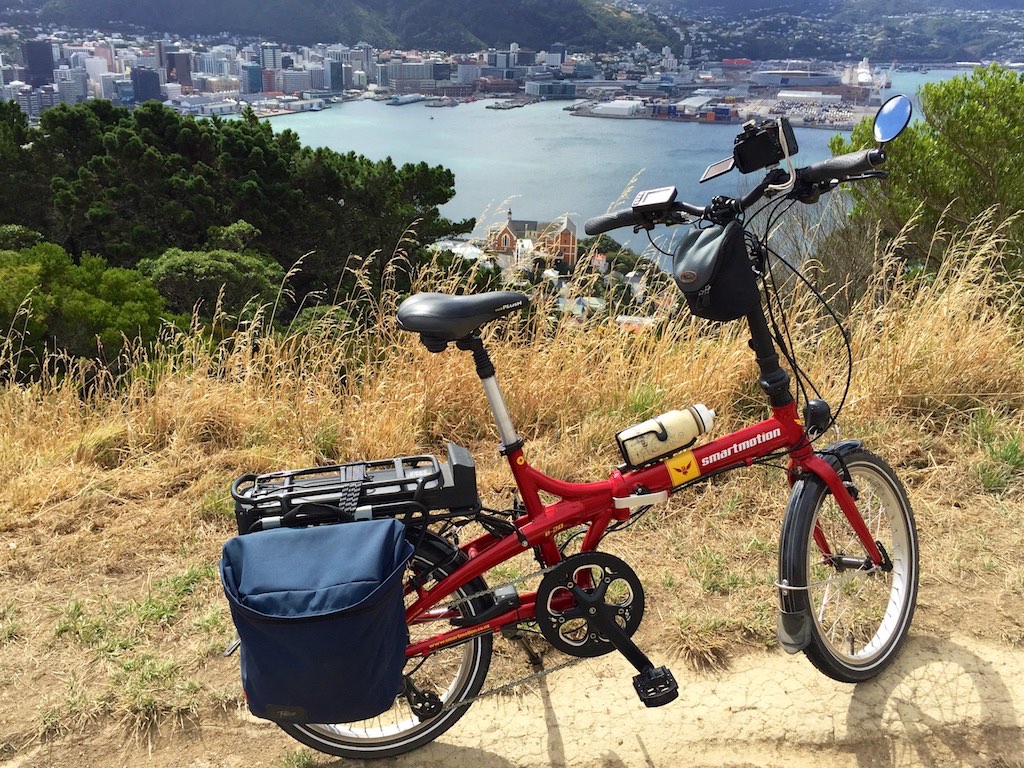
Components
Saddle
The Velo-Plush saddle is large, comfortable and is mounted on a suspension seat-post. For me this is somewhat unnecessary given the saddle is soft and the tyres are wide. The seat-post is painted black but it marks easily, exposing the bright aluminium underneath. I have since removed the paint, with the added benefit of improved clamping. The saddle weighs 605 g and the seat-post weighs 609 g. I may replace it with a lighter saddle and an anodised aluminium seat-post which should halve the total weight and feel similar to my other bikes. The current seat-post is 30.3 mm in diameter and 400 mm long, so any replacement should be of a similar size and length.
Lock
The bike has a very nice built-in Dutch style café lock which, for extra security, can be used with a separate end-looped cable to secure the bike to an object. It weighs 407 g. It is unbranded, but it looks to be similar in style to an AXA Defender RL frame/wheel lock.

The key does not have to stay in when it is unlocked, which means it can remain on a key-ring.
Folding Clamps
The stem and frame clamps use a simple over-centre design which is easily adjustable. Safety locks are provided.
Chain Guard
The chainwheel has 52 teeth and it has twin aluminium chain guards which protect trousers and also prevents any chain drops over rough ground.
Cassette
In the rear there is a Shimano HG41, 8 speed, 11-34 tooth cassette and a Shimano Altus derailleur. This is gives a range of 30.7 to 94.9 gear-inches, 2.45 to 7.57 metres-development and a gain-ratio from 2.29 to 7.09. These terms are defined in Sheldon Brown's article about Gain Ratios.
Wheels
The wheels have 36 stainless steel 13 gauge (2.3mm) spokes which are thicker and therefore stronger than usual. The Alex 303 aluminium rims are also quite substantial.
The front wheel, plus the tyre, weighs about 1.8 kg. The rear wheel should have a similar weight, not including the motor weight, the cassette and free-wheel mechanism at 4 to 5 kg.
Tyres
The Kenda tyres are marked as 20 x 1.96 inches and 406 x 50 mm in size which is wide and comfortable for a folding bike. The actual diameter when inflated on the wheel is about 510 mm. I do not understand tyre markings, which only roughly approximate the actual sizes. Here "406" refers to the rim size, which only adds to the confusion. I have seen 20 inch tyres which range from 18 to 21 inches in diameter A kevlar band inside helps to protect the tyre from punctures. The pressure range is 40 to 66 psi or 2.8 to 4.5 bar.
Tyre Pressures
The correct tyre pressure depends on the load it carries. Tyre drop is how far the wheel moves towards the road when it is loaded. It is expressed as a percentage of the tyre width.
A common figure for an ideal tyre drop is 15%. This may require lower pressures than normal, but the bike will be no slower, or difficult to handle. Useful information on tyre pressures is at Sheldon Brown's website and at Off The Beaten Path
In order to allow some time between checking tyres I have adopted a 10% figure. For my 50 mm wide tyres this corresponds to a tyre drop of about 5 mm when loaded, by sitting on the bike. For me the approximate corresponding pressures are:
- Front: 20 to 30 PSI.
- Rear: 30 to 50 PSI.
These pressures should allow riders with a range of different weights to have a comfortable ride. To get these values I had to sit on the stationary bike while using a vernier calliper to measure the wheel rim drop. This was easier than it sounds.
Potholes and Wheel Size
It is often claimed that smaller wheels are much worse on bumpy roads. In fact, the response of different wheel sizes is fairly similar. With a 510 mm diameter wheel a 230 mm diameter pothole, when bridged, will cause a 25 mm drop of the wheel. With a 660 mm diameter wheel the drop is 23.5 mm, which is 1.5 mm less. With a 690 mm diameter wheel the drop is 21.6 mm, which is 3.4 mm less. This is experimental data. These differences may be greater for larger potholes, but the tyre will now likely roll across the bottom, still producing a similar response. The tyre width, tyre pressure, balance and the sudden diversion of the steering is more important. On any bike a pothole can cause trouble.
Brakes
The Tektro brake levers and Shimano gear shift levers are shown at right. There is a Hall magnetic sensor located on the underside of each brake lever which cuts power to the motor when a brake is applied. The left-hand brake lever has a very nice built-in bell. A specified 180 mm disk brake is not fitted to the front wheel. V brakes are perfectly fine, and lighter, for this class of bike.
The brake cut-outs complicate the wiring around the handlebar. For legal hub motors they may not be needed. The motor stops within one second if pedalling ceases anyway. For a future model my first thought would be to replace the cut-outs with an accelerometer. When the brakes are applied the bike decelerates. This can be sensed by an accelerometer which instantly reduces the motor current. Alternatively the sudden increase in motor current, as the brakes are applied, could be sensed.
The sudden change in motor current gives enough information for a software solution.
The case for brake cut-outs is also diminished by the fitting of effective brakes. There is still the problem of losing the control of the bike by accidentally activating the throttle while walking the bike. A thumb-throttle may fix this problem. Reducing its operation to walking-assist speeds only, as a program option, may also help.
Additions
Mirrors
A CatEye bar-end mirror was fitted to each bike. This addition is probably the most important as it contributes to safety. You can see the line that traffic is taking behind you, whether any indicators are flashing, and the approach of other cyclists. I have used a bar-end mirror on my mountain bike since the late 1980s. When riding on busy roads it helped me assess the space that wide vehicles, such as trucks, would leave me. I filed some plastic off the inside of the end-cap so the mirror tilted out further. This prevented it being knocked by my hand, during rides.
If you are a motorist, motorcyclist or an inexperienced cyclist, a mirror will be a great aid to safety. It also assists with improving my balance issues. When choosing a mirror, make sure that the field of view is sufficiently wide, so that the mirror position does not need frequent adjustment.Bags
I have added a Phillips handlebar bag to each bike. It is a versatile removable bag which still allows the bike to fold properly. We used this bag, along with a carry-all sports bag on the carrier, for light touring in the Nelson area.
Cameras
Over the years I have used several cameras with my folding bikes. These include a Canon Powershot A590, A Canon G11, a Canon G15, An Apple iPhone 6 and a Panasonic DMC-FT30 waterproof camera. The last two cameras were either mounted on the handlebar or behind the seat depending on the view required or the sun position in the sky. I also used the time-lapse photo mode on some rides. Occasionally the cameras excelled themselves with some nice images, especially on joint rides. I looked at the GoPro range of cameras but I felt they had a too wide and curved field of view for my tastes.
The Panasonic DMC-FT30 camera was much cheaper and produced good quality images. Make sure the lens is clean. If a cloth is not available take a rectangle of toilet paper. Fold it in half, roll it up and then pull it apart in the middle. Use the exposed end to clean the lens - it behaves like a cloth and a brush. Breathe on the lens if necessary.
I used a simple shade to help with LCD viewing. It was made out of a black report cover and some elastic tape held it in place. An extended camera mount on the handlebar allowed the camera to view over the Phillips Handlebar bag. It made using the LCD display more comfortable too. Under the seat I use a modified $20 Selfie-Stick camera mount. The stick was removed and the camera holder was mounted on a tab using adjusting parts from an old brake-pad to angle the camera correctly. An elastic hair-tie helped to retain the camera. My camera settings are as follows:
- Picture Size - 14MB 3:2
- Sensitivity - ISO
- White Balance - Auto or Cloudy to taste. Cloudy might be best when outside under trees, for example.
- AF Mode - 23 Area
- Face Recog. - OFF
- i.Exposure - ON This is a mild version of HDR
- i.Resolution - i.ZOOM Adds some extra zoom while keeping picture quality.
- Digital Zoom OFF
- Burst OFF
- Time-lapse Shot - Set as Required
- Color Mode - STANDARD
- AF Assist Lamp - OFF
- Red Eye Removal - OFF
- Stabilzer - ON
- Date Stamp - OFF
- Clock Set - Remember to change for Daylight Saving
I use the Normal Picture recording mode. When I use time-lapse I usually set it to a 3 minute intervals for 60 photos which then lasts for a 3 hour ride. There are usually a few very good photos at the end of the ride, while the majority can be safely discarded.
Recently I have been taking my Pentax K5 SLR camera in the bag. In good light the Panasonic DMC-FT30 camera compares well. I often need to check which camera took the photo when I review the photos as a group.
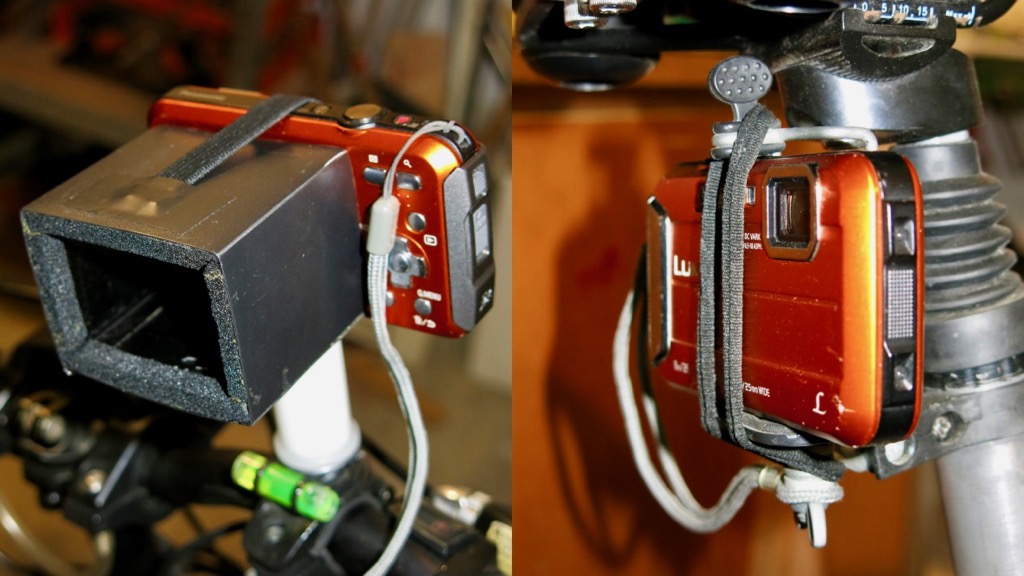
Adjustments
Saddle Adjustment
There is a single bolt underneath the saddle which, when loosened, allows the saddle to be tilted and slid forwards and backwards. The saddle should usually be level and the horizontal adjustment should be in the middle of the range as a starting point. Small adjustments to the saddle height, tilt and horizontal position can be made in small increments over a period of time until a comfortable setting is obtained. When the bolt is tightened wiggle the saddle and tighten again. This ensures everything has slipped into position and is firm. This is a good reference - Sheldon Brown - Saddle Adjustment.
Kick Stand
I found a minor problem with the kick-stand. When closed, the stand foot touched the rotating motor body which produced a ringing sound. Some paint was also scraped off the motor. The cure was to shorten the lower leg, by adjustment, or to add a shim under the frame mounting point. The shim would also cure the small clearance of the upper part of the leg from the tyre. Another option is to change the kick-stand brand.
I ended up shimming the mounting plate at the back with a 40 mm length of an old 14 gauge spoke. This allowed an increased motor clearance of 10 mm and a longer leg adjustment for a more upright stance of the bike, when parked. The parked bike was much more stable when loaded for touring.
The downside of most kick stands is that nearly level ground is needed for stability, particularly when the rear carrier is loaded. Leaning the bike against an object is another option. A rear mounted kickstand, attached near the rear wheel hub, might be better.
Mud Guard
I had to adjust the front mudguard upwards on my bike as it was lightly touching the tyre. I also had to add an extra washer to the bolt holding the right-rear mudguard stay onto the drop-out. The bolt was just slightly too long. On Désirée's bike the chain occasionally touched the end of this bolt producing a clicking sound.
Throttle Control
On odd occasions we have both nearly lost control of the bike while standing and inadvertently moving the throttle. As the bike moves forward the throttle setting naturally increases. The held bike then rears up, reducing the throttle setting only slightly. A tilt switch might help to prevent a total loss of control. Reactivation would then require the throttle to be returned to its zero setting. Using either brake lever will instantly stop the motor.
Walking Assist
The walking-assist function was very helpful, but the "+" button was difficult to keep reliably pressed for a long time. The pressure required is too high, particularly for people with painful joints. A better tactile switch is needed for this function. Alternatively the walking-assist function could be reprogrammed.

Holding down the "+" button for two seconds would engage the 6 km/h setting. The throttle would be used as a 6 km/h start and stop control. Touching the "+" button again would return the bike to normal operation. Normal operation should also be restored with a timeout function, or a link to the pedelec system. This would ensure safety at intersections, where the throttle may be required for a fast start.
A permanent 6 km/h walking assist option in the setup could allow the throttle to activate just this feature.
Wear
Eventually some items will wear out. The most likely items are the tyres, chain, rear cassette, brake cables, derailleur cable and brake pads. Some bearings may need adjustment or replacement.
The rims will eventually wear out from braking. There are wear marks engraved into the rims. These should always be visible.
Note that with a mid-drive bike the chain and sprocket wear can be higher if the tasks demanded from the bike are harder than previously. Extreme hill climbing comes to mind.
With a hub drive the wear may be lower because some of the motive force is directly applied by the motor to the wheel. The personal input via the chain and sprockets can therefore be somewhat lower.
It is interesting that with our drivetrain we are only just considering chain replacements at nearly 3000 km of service. A measurement with a chain gauge showed that the wear rate is low.
Chain Lubrication
The life of a chain is maximised if it is lightly oiled with a low viscosity oil, similar to sewing machine oil or automatic transmission oil for cars. First the chain should be wiped clean with a few rags or paper towels. Use a few drops of oil on the rag to help remove any black wear deposits. Try to clean the cassette, derailleur idlers and the chain wheel as well. An old dish brush is good for this. Oil the chain by rotating the chainwheel backwards and letting the oil drop onto the lower inside part of the chain. Oil the derailleur idler bearings as well. After a delay, to let the oil penetrate, wipe as much oil as possible off using a clean rag. The idea is to have sufficient oil inside the chain, where it is needed, but almost none on the outside where it can attract abrasive dust. Dispose of any oily rags to prevent future fires.
The longer chain life compared with our other bikes is due to the rear hub motor reducing the chain loading, especially on hills.
The wear rate can be high if the chain isn't clean. In an abrasive environment when the chain load is doubled the wear rate can increase by as much as 8 times. Under clean conditions the wear rate is usually proportional to the loading. This is why mountain bikes need so much maintenance when ridden hard, especially under dirty conditions.
Spoke Tension
The spokes may need re-tensioning as the wheels settle with use. Most 20 inch rims are quite accurately made so all the front wheel spokes should produce a similar tone when tapped. The rear wheel spokes should produce two tones depending on which side of the wheel the spoke is on. The cassette side should produce the highest tone.
As a group, the tones on a particular side should be the similar. The odd sounding spokes should be adjusted to sound the same as the others. A minor amount of additional trimming should then produce a true wheel.
My front wheel has an average spoke frequency or pitch of 600 Hz (just under a D sharp). The rear wheel average pitch is 1000 Hz (just above a B) on the cassette side and 800 Hz (just under a G sharp) on the other. These notes are found, on the piano, in the octave above middle C.
The higher pitch, or tension, on the rear wheel is because it carries a higher load than the front wheel. If the rim is not inherently true then the tones will differ as extra tension will be needed on some spokes to apply corrections. More information can be found in Sheldon Brown's article on Wheel-building.
The spokes are 13 gauge so a 3.7 mm spoke-wrench is needed. Professionals measure spoke tension instead of tone.
Specific Folding Bike Adjustments.
Some items specific to the folding mechanism may need attention.
Hinge Clamp Adjustment
When a hinge clamp is closed it applies a force onto the head of an adjustable bolt. The bolt screws into the clamp-bolt pin at its mid point, This transmits a compressive force to the hinge plate which prevents it from moving. An Allen key can be used to adjust this bolt. The steerer clamp is shown at right
The clamp moves through a 90 degree arc. A resisting force should be felt when the clamp is within about 20 degrees of closing. The tip of the clamp then has about 30 mm further to move before it is fully closed.
I set the clamp closing force in the range of 30 to 60 Newtons or roughly equivalent to the downward force of 3 to 6 kilograms. It turns out that a basic digital luggage scale can measure pushes as well as pulls. I placed a small rubber pad on the clamp and pushed on it with the luggage scale until the clamp closed. If the maximum reading was in the range -3 to -6 kilograms then the adjustment was correct. In essence, this was a firm, but not a difficult, closure. You could close it by pushing with the palm of the hand, but not with just a single finger.
The clamps have plastic safety latches which should be rotated into place.
Set-Screws
The steerer hinge uses a pin, like in an ordinary door hinge, which is kept in place with a set-screw. This set-screw should be reasonably tight and checked periodically. Some Loctite 243 can be applied to the thread of the tightened set-screw to ensure that it does not drift outwards, releasing the pin. This might happen on long car trips where the bike is folded and the hinges are free of any tension. The clamp pin is retained in place by a Cir-clip.
The frame hinge has two pins, one for the clamp and one for the hinge itself. They are each retained with a set-screw. The set-screws should be tightened and held in place with Loctite 243.
When the bikes are ridden, there is an oscillating force present at the base of the set-screws which might cause them to loosen. This needs to be prevented. The set-screw for the frame hinge fits below the hinge pin, so it would have to loosen a lot for the hinge pin to be released. The remaining two pins have their sides recessed to accommodate a set-screw. This means that a set-screw needs to rotate several turns anticlockwise before a pin is released.
In aircraft engineering, screws were often retained by lock-wires. The wires were threaded through a hole in the head of a screw and through similar holes in adjacent screws. Often the wires were twisted in pairs with a specific threading pattern between screws. One wire would go through a hole in the screw head while the other wire would run over the top. Here, Loctite 243 is almost as good.

1000 km
To Kaiteriteri 11 - 18 March 2015
We completed a March 2015 trip from Wellington to Kaiteriteri at the top of the South Island. This involved cycling to Johnsonville early on a dark morning using our built-in lighting system.
A commuter train took us into Wellington where we caught the Bluebridge Ferry to Picton. We rode from there to Pelorus Bridge via Queen Charlotte Drive and Havelock.
On our second day we rode over the Rai Saddle and the Whangamoa Saddle to Nelson.
On the third day we rode to Mapua via Rabbit Island and the Mapua Ferry.
On the fourth day we rode on to Motueka and did a 20 km battery-less return ride along the estuary and waterfront.
Our ride to Kaiteriteri and back the next day was scenic and interesting. We rode the road and trail route towards Kaiteriteri and the Mountain bike trail on the return.
Return Trip
The return to Wellington ride was from Motueka, Mapua to Nelson. From Nelson we folded our bikes into our Giant Expressway bike bags and presented them as luggage for a bus trip to Picton. We rode the bikes around Picton and Waikawa Bay because the Ferry was delayed. During this ride my display showed that I had ridden 1000 km since purchasing my electric bike.
In Wellington we waited for 30 minutes, caught the train to Johnsonville and then rode home in the dark. In total we rode about 340 km over some substantial hills and unsealed trails.
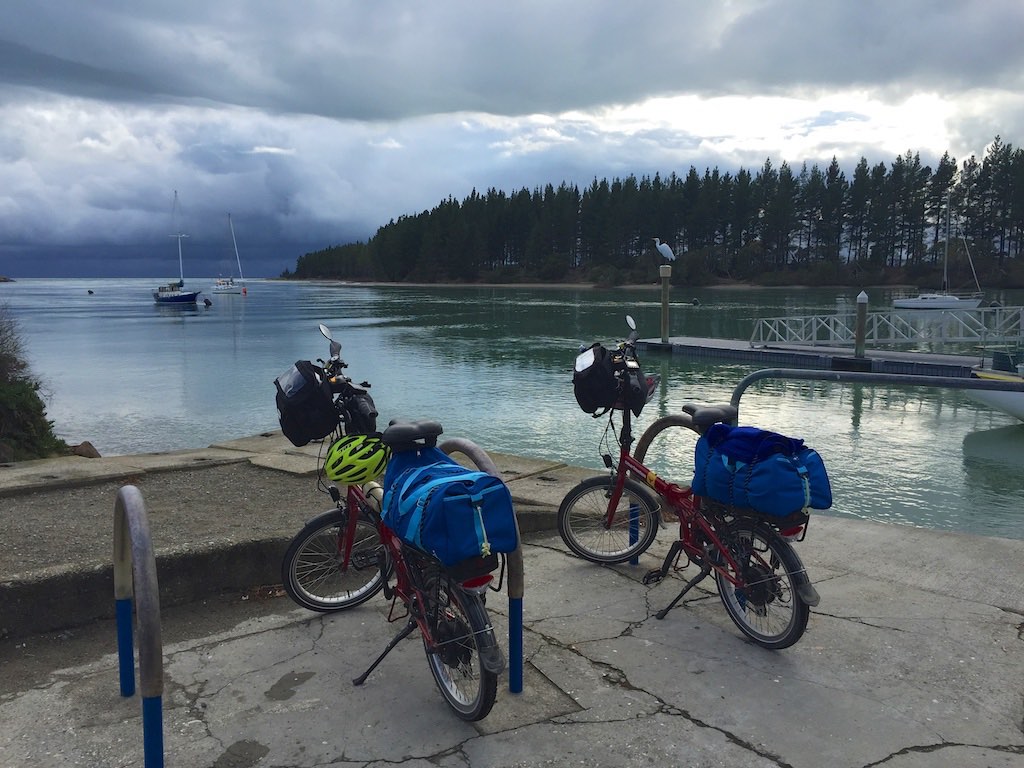
Maintenance
We had few problems with the bikes. A pedal loosened on Désirée's bike and started to lock up. This was a ball bearing failure which can be easily fixed at home. We purchased some lightweight 150 g replacement pedals, which worked well. The old pedals weighed 240 g each. They seem to have quality issues as well, since all four pedal shafts were slightly bent, which probably contributed to the bearing failure.
A rough indentation test showed that the folding pedal shaft hardness was about a quarter that of a more expensive plain pedal shaft. Using my X-ray spectrometer I found that the pedal shafts were made from a tempered chrome-manganese steel. This is iron with a fraction of a percent of chromium and manganese added to increase strength. The differences in hardness reflects the care taken in the thermal tempering process. I have since replaced all the pedals as we rarely folded them.
Metal hardness needs to be specified for a particular application. Too low hardness may cause items to loosen or bend while too high hardness can cause them to break. Even bolts and washers need to be correctly hardened. It is common to see washers seriously deformed by the simple act of tightening a bolt. Pedal anti-rotation washers are a good example. They tend to perform well, only once.
The bike kickstands need careful adjustment if the bike is carrying luggage. With our loaded bikes we had to be careful about bike stability and the optimum length of the strut. Our luggage was about 6 kg in the rear bag and 3kg in the front bag, including the bag weights. I had the same kickstand problem with my old Tarini mountain bike when I did some touring around Nelson and Takaka. With care, the problem is not too serious. Using a stand designed to be mounted closer to the rear axle may help.
I recently had a problem with one of our batteries. I keep a check of the battery voltages with a small digital multimeter. This is to make sure that the charge and discharge voltages are OK and within a safe range, and that the chargers are not doing anything unsafe. To do this I have a special adaptor so I can plug the meter into the charging port. Unfortunately the adaptor plug developed a minor short which produce a brief arc inside the plug. The plug and wiring was undamaged. The net result was that I was no longer able to charge the battery because of some electronic failure inside. Everything else was OK. The battery management board inside the battery may need to be reset or replaced.
I now have a replacement battery. Thank you Daryl.
The bikes were able to cope with hilly rides in excess of 60 km with around half of the displayed battery capacity remaining in each case. I suspect the remaining capacity of the battery would be depleted faster than the first half, since the voltage is lower and the demand on the battery increases to compensate. Note that the range obtained depends on the rider input. I have still not been able to flatten my battery within one day's riding.
Back in Wellington, on a weekend ride, we did a fast 7 km ride in cold and driving rain without any problems. We were caught out, so we made a 30 km/h, level 5, dash to get to our car.
2000 km
I have now completed more than 2091 km. Désirée has ridden over 1859 km. For the first time, I have adjusted the derailleur cable, on my bike, half a turn anti-clockwise for smoother gear changing. The brake pads are still fine. The chain is not worn. The battery capacity is still very good. The motor sounds the same. The tyres have plenty of tread left. Our tyres remain unpunctured in nearly 4000 km of riding. There are still no issues with either bike.
Our longest ride so far was from Paeroa to Thames and return - a total distance of 72 km on gravel, on a cold day and in a moderate cross wind. There were some detours for food. The indicated battery capacity was a bit below half at the end of the ride. Mostly we used level 3 but we did use level 4 for the last few km. Obviously we did a fair amount of pedalling as well.
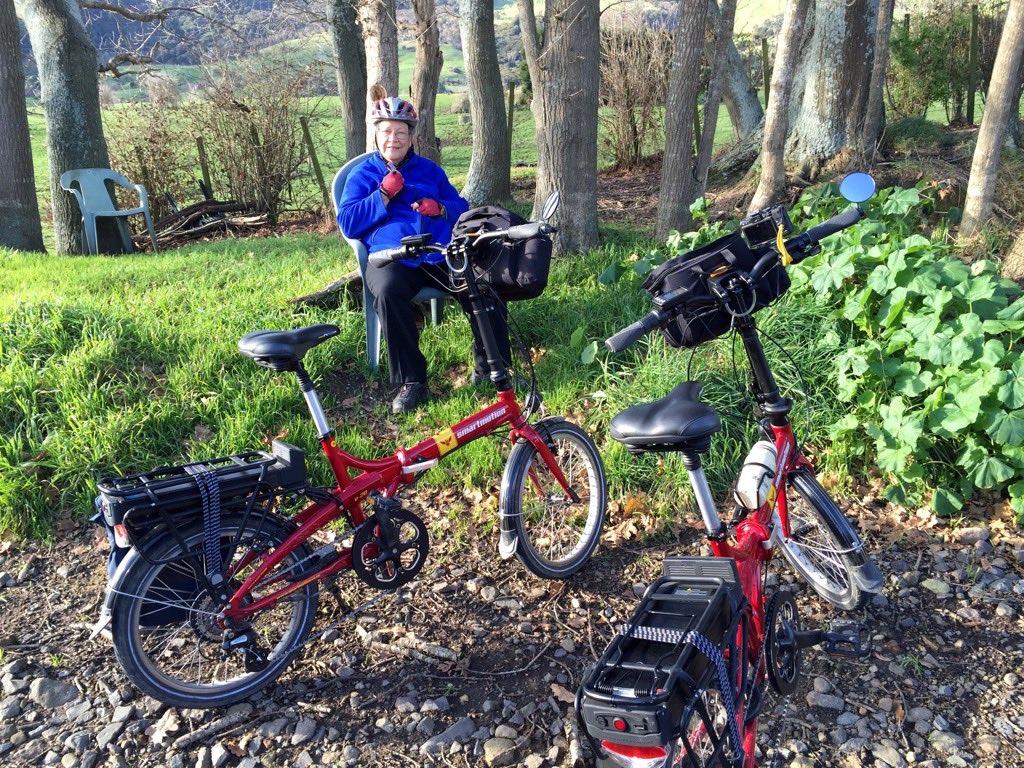
3000 km
My bike has reached 3135 km with no major issues. I did change the chain recently as there was some minor wear. An early $20 replacement can extend the life of the rear cassette. The battery is still fine with a good range. The 10 magnet pedelec disk is working well and makes the bike much smoother to ride. The electric motor now assists just at the right time. Both our bikes now have this upgrade fitted.
Martinborough - Gladstone - Martinborough loop 02/03/2016
We did a recent ride near Martinborough of 72 km. The ride was a loop through rolling countryside via Gladstone with only one wrong turn included. We arrived back with 4 to 5 bars out of 6 left on the display. Again, we had put some effort into our riding so the motors assisted mostly on hills and into the wind.
4000 km
My bike distance is now 4014 km, again with no major issues. The battery is still producing a good range, in excess of 70km.
We still have not had any punctures and there is plenty of tread left on the tyres. The brake blocks are original, which is surprising since we often ride on steep hills. Both bikes still ride silently. I do a chain clean and lubrication, every few weeks and I also check the frame, wheels, bearings and various other components.
5000 km
Nothing to report. No punctures, but plenty of off road riding. The brake blocks are still fine. A recent ride was 52 kilometers with plenty of battery range left. Basic maintenance is keeping the tyres at a suitable pressure and lightly oiling the chain and derailleur. Excess oil is always wiped off to discourage dust accumulation. The chain is checked for wear and the brake cables are checked for any strand breakages.
6000 km
Still little to report. No punctures, with plenty of off road riding. I have done several rides longer than 50 kilometers still with plenty of battery range left. The brake blocks are original and in good condition. The brake adjustments have been minor. I adjusted the headset to remove some very slight play. I resoldered an electrical lug on the front light which was intermittent. Routine maintenance, described above, was carried out. I may fit new locking hand grips soon as the old ones rotate a bit with use.
LCD display error at 6553.9 km
I have noticed that my LCD display resets to 6553.9 km when powered up. It can advance normally beyond this point during a ride, but it always resets to 6553.9 km when powered up again. I am waiting for Désirée to reach the same distance so I can determine if this a general programming error, or just with my display. So sadly, I may never reach 10000 km on the e20. Note that 65536 is the binary number 216 which may be the source of the error. The counter went 3 counts over and stalled at 6553.9. Also the trip counter now zeros to 44.7 km after power on which is harder to explain. Holding UP, DOWN And SET reset the display, so I can now start again.
First Puncture
On a ride in Paekakariki I experienced a slow puncture in my rear tyre, at the end of the ride. At home I extracted a 2 mm glass fragment, which had gradually worked its way through to penetrate the tube. This fragment is likely to be from a larger shard of glass which has broken and worn down as the tyre rotated. The remaining fragment irritated the tube over some time, until a slow leak occurred. The repair involved removing one side of the tyre from the rim using tyre levers, extracting the tube and patching it. I removed the glass fragment from the tyre by pushing it outwards, from the inside, with a sharp probe. The rear wheel did not need to be removed but the brake cable was released to make room.

7000 km
No major issues to report. I repaired another slow leak in the rear tyre from a glass fragment. I simply patched the tube in place rather than removing the wheel. The glass fragment was removed from the inside of the tyre. Désirée's display also stalled at 6553.9 km and the display needed to be reset.
8000 km
We completed the West Coast Wilderness Trail and the The Kaikoura Kowhai Trail without major problems. In total, we had one slow leak in a front tyre and an intermittent electrical fault which was cured by binding the loom extension cable in a loop near the offending connector. I also lost a mirror insert during packing or unpacking, which I replaced. The brake-pads and tyres are still original and have a long way to go before I would consider them worn. On my other bikes the brake-pads show more wear for much less use.
One of our bikes developed a problem with a frame clamp-bolt pin. For over 8000 km these folding frame clamps have been trouble free but recently I noticed, on one bike, the clamp-bolt pin was getting difficult to move in spite of lubrication. This made locking difficult and the pin was therefore replaced. It turned out that the that the pin had bent slightly because of a crack at the mid-point. The pin mid-point is the weakest point because it is drilled to receive a 6 mm bolt. The crack may have started due to loading, corrosion or manufacturing defects. This is the nature of many materials under stress for long periods. I machined a new part using an English grade of stainless steel with a similar nickel content and hardness. I am sure suitable spares can also be obtained, but since the original part cracked, my replacement may be better.
It is possible to subject some grades of stainless steel to moderate repeated stresses and have an essentially infinite fatigue life. A total failure of this part would not necessarily cause any bike instability as it is confined inside the frame. It would simply make the frame clamp almost impossible to close because of the initial bending. If there are changes like this they need to be followed up by a close inspection of all related parts. Clamping forces should not change or require adjustment in the short term.

I lightly sanded the fitting so some dark debris would fill the cracks and make them easy to see and photograph. I initially did not notice them.
We have not been terribly kind to our bikes and we have ridden them for over 4 years in remote places without major problems. Most well used bikes require periodic maintenance to keep them running smoothly. Mountain bikers have on-going maintenance issues with suspensions and other moving parts, for example. In our case, the folding parts need to be watched for any changes, with only one partial failure so far. This might involve the removal of all pins, visual inspection, lubrication and refitting. The normal bike components, such as cogs, bearings, chains, pedals, brakes, derailleurs, wheels, tyres and spokes, have all lasted well.
9000 km
There are still no major issues. I have now replaced the chains on both bikes. These chains lasted much longer than the originals because I kept them clean. I removed excess oil with a rag so abrasive dust could not accumulate. Hub drives are kinder to chains and cogs as the motor power is applied directly to the wheel. The smaller effort required from the rider reduces transmission wear.
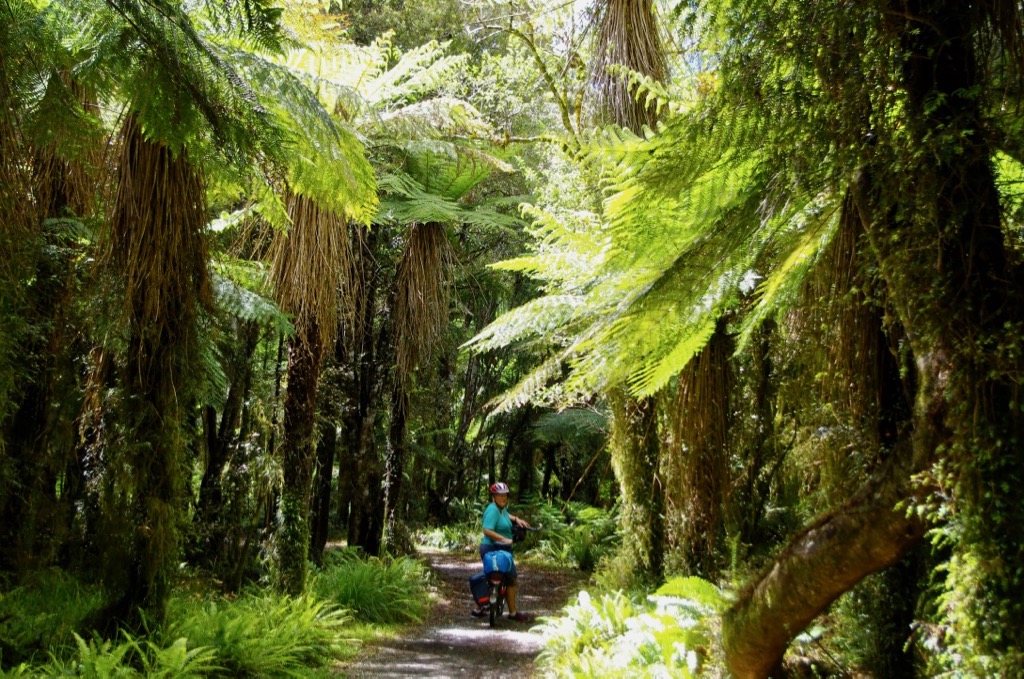
10000 km
We have both exceeded 10000 km. I am slightly behind Désirée as I have been riding my Jamis hybrid bike, or my Giant folding bike, to improve my fitness. Surprisingly, the ebikes still have plenty of wear left on their original brake blocks. The original rear tyres were now fairly well worn. I moved the front tyres to the rear and, on the front wheels, I fitted new Maxxis Hookworm 20 inch BMX tyres.
My method of battery management has seen no significant loss of capacity over 6.8 years of regular use. I simply operate the bike batteries in the linear part of the remaining battery capacity curve.
11000 km
We have both ridden our e-bikes more than 11000 km.
We recently did another South Island trip. This included circumnavigating Lake Hayes, with elevated tracks and a long board-walk at the northern end. We did return trips from Ohau Lodge, to the north-west end and to the the south-east corner of lake Ohau. The bikes performed well. The bikes are now 8 years old and still use the original batteries and brake pads. We are close to replacing the rear tyres, probably with Maxxis Hookworm 20 inch BMX tyres. We have these on the front.
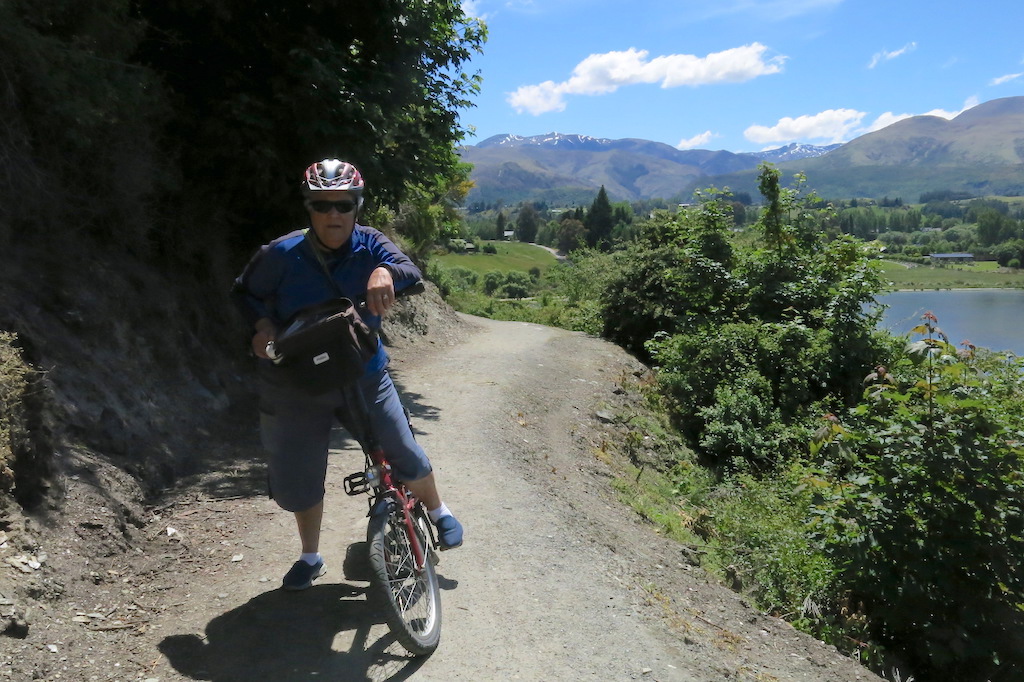
12000 km
November 2023. Nothing to report. The bikes still do everything we expect of them. Shortly we will do another south Island trip.
Conclusion
As with the Giant Expressway 2 folding bikes, we will gradually customise these bikes to our needs. We hope to do a range of interesting new rides. On several recent rides we found that we could keep pace with each other on hills and in strong head-winds. This makes for much more sociable riding, and more opportunities for riding.
My advice when choosing an electric bike is to keep things simple. The electric motor can compliment a basic gearing system such as a 3 speed hub. The best test of an electric bike is to first ride it unpowered. Then ride it on terrains similar to your intended routes. Find a good local bike shop. I have been thinking about Electric Dutch Bikes recently as, mostly, they are good value and nice to ride.
Our bikes are accepted on local trains, usually in an unfolded state. On busy trains or buses they may need to be folded. I might also use a bike bag.
We often use our bikes to ride down to Café Thyme on Middleton Road near Churton Park. It is a seriously steep climb back home and we often shop at the supermarket as well. The electric assist makes the ride enjoyable and it saves using the car too much.
I have added some links under the heading "Innovation" as folding, or lightweight, bikes, lightweight motors and low cost, 36 volt, power tool batteries may be used in the future for assisted bike riding. The ideal electric bike has yet to be designed.

JEP Links
JEP Related LinksArts & Letters Daily
BBC News - Home
Radio New Zealand News Headlines
ScienceNews
ScitechDaily
Spike.News
Universe Today
xkcd
Bike Reviews
Giant Expressway 2 Folding BikeSmartMotion eMetro Electric Bike
SmartMotion Vista Folding Electric Bike
Jamis Allegro Sport Fitness Bike
Bickerton Portable Folding Bike
Manufacturers
SmartMotion e20 Folding Electric BikeTern Vektron Folding Electric Bike
Onya Folding Electric Bikes
ROBIN Folding Electric Bike
Magnum Folding Electric Bikes
GOCYCLE Folding Electric Bikes
Selected Dealers
Wellington Electric BikesBurkes Cycles
Bicycle Junction
SwitchedOnBikes
Blogs and Links
Dizzy's Folding Bike BlogPedelecs
Electric Bike Review
Endless-sphere.com
The Prospectory
SlowCycles
Alastair's Blog
Cyclopolitan
Cycle Wellington
Cycling And Hiking Adventures & Detours
Maintenance
Sheldon Brown ArchiveMadeGood Bike Repair
Battery University
EBike Battery Repair
Lithium Battery RepairBattery Repack Ltd
Trails and Touring
AATravel Alps2Ocean-Cycle-TrailChristchurch official visitor guide
Clutha Gold Trail
crazyguyonabike - Bicycle Touring
Mount John Observatory Tekapo
Hawke's Bay cycle trails
Hyde Otago Rail Trail Accommodation
Kennett Brothers Limited
Must-Do's: Cycling Travel Guide
Otago Central Rail Trail Official Website
Otago Rail Trail
Mackenzie Country Tekapo Canals Alps to Ocean Cycle Trail 5 day bike tour
New Zealand Cycle Trails
Ngā Haerenga - Great Rides of New Zealand
Queenstown Trails
Tasman's Great Taste Trail
Trail Hub
Trail Journeys - Otago Central Rail Trail, Roxburgh Gorge and Clutha Gold Trails
NZ Topo Map - New Zealand Topographic Map
Ultralight bicycle touring
Wellington Cycling - New Zealand
Mountain biking in Wellington NZ
Waimakariri Eastern Cycle Trails
Innovation
Lekkie conversionsARCC assist e-bike system
Two speed motor
Bike calculations
Bike1 - HP15c ProgramsDM15c Scientific Calculator
Bike Calculator
Ebike Motor Simulator
Click the photos below to enlarge. Use the browser "back control" to return.
 36 volt battery and LED taillight
36 volt battery and LED taillight
 LED Headlight
LED Headlight
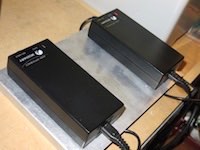 Twin battery chargers
Twin battery chargers
 Brake lever, Hall sensor and gear shifter below
Brake lever, Hall sensor and gear shifter below
 Built-in bell
Built-in bell
 saddle and suspension seat-post
saddle and suspension seat-post
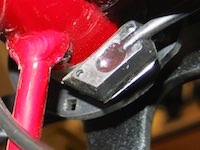 Pedelec sensor
Pedelec sensor
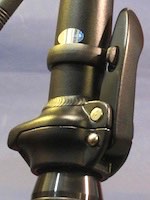 Locked stem-clamp
Locked stem-clamp
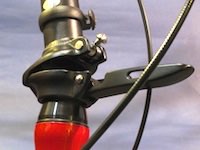 Stem-clamp open
Stem-clamp open
 Bike stand foot near motor
Bike stand foot near motor
 Bike stand shaft close to tyre
Bike stand shaft close to tyre
 Twin chain guards
Twin chain guards
 Shimano Altus derailleur and HG41 8 speed 11-34 tooth cassette
Shimano Altus derailleur and HG41 8 speed 11-34 tooth cassette
 Throttle and display
Throttle and display
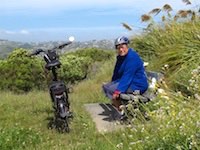 After a steep hill climb
After a steep hill climb
 Oak Avenue - Hawke's Bay
Oak Avenue - Hawke's Bay
 Wineries Ride - Hawke's Bay
Wineries Ride - Hawke's Bay
 Wellington from Tinakori Hill
Wellington from Tinakori Hill
 Church - Makara Village
Church - Makara Village
 Tinakori Hill - Wellington
Tinakori Hill - Wellington
